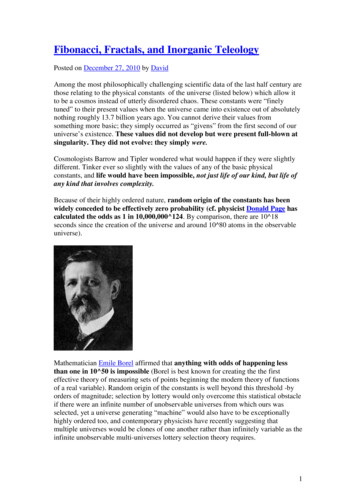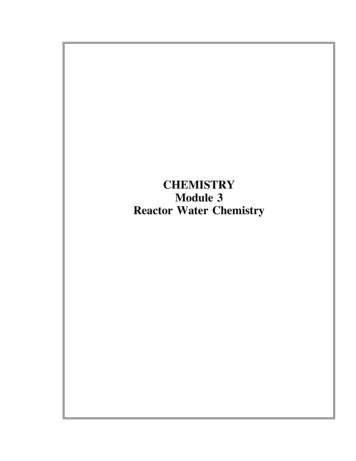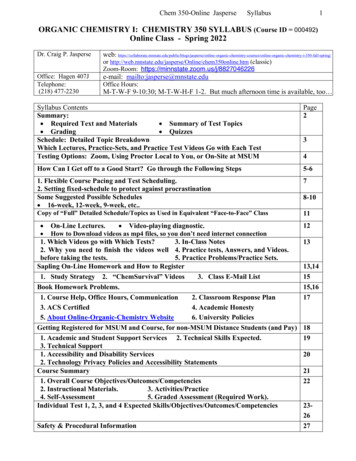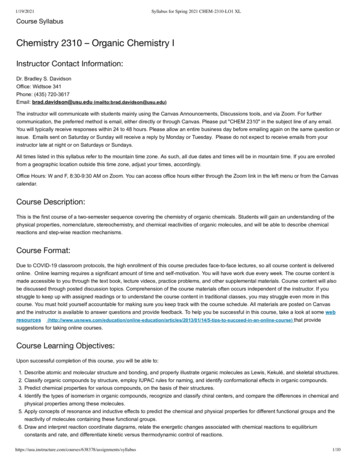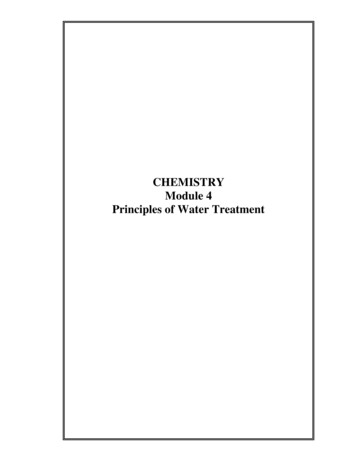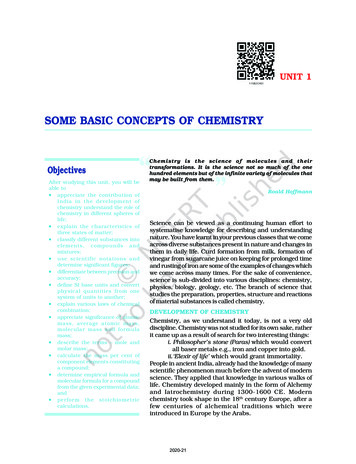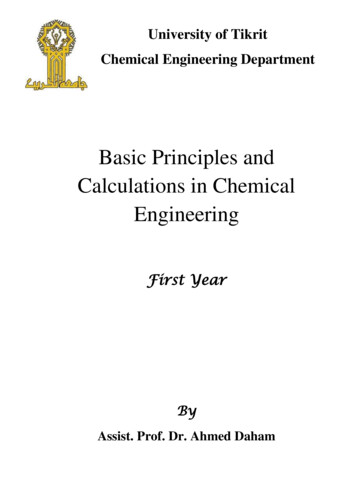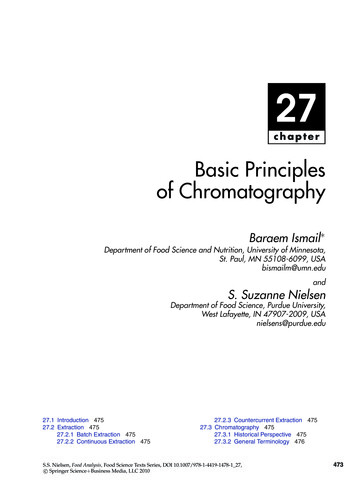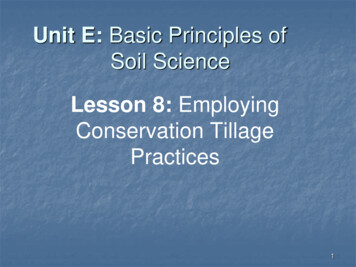
Transcription
BASIC PRINCIPLES OF INORGANIC CHEMISTRYMaking the Connections
RSC PaperbacksRSC Paperbacks are a series of inexpensive texts suitable for teachers andstudents and give a clear, readable introduction to selected topics in chemistry.They should also appeal to the general chemist. For further information onavailable titles contactSales and Promotion Department, The Royal Society of Chemistry,Thomas Graham House, The Science Park, Cambridge CB4 4WF, UKTelephone: 44 (0)1223 420066Fax: 44 (0)1223 423623New Titles AvailableArchaeological Chemistryby A. M . Pollard and C . HeronFood - The Chemistry of Its Components (Third Edition)by T. P. CoultnteThe Chemistry of Paperby J . C. RobertsIntroduction to Glass Science and Technologyby James E. ShelbyFood Flavours: Biology and Chemistryby Carolyn L. Fisher and Thomas R. ScottAdhesion Scienceby J . ComynThe Chemistry of Polymers (Second Edition)by J . W. NicholsonA Working Method Approach for Physical Chemistry Calculationsby Brian Murphy, Clnir Murphy and Brian J . HathawayThe Chemistry of Explosivesby Jacqueline AkhavanBasic Principles of Inorganic Chemistry-Making the Connectionsby Brian Murphy, Clair Murphy and Brian J . HathawayExisting titles may be obtained from the address below. Future titles may beobtained immediately on publication by placing a standing order for RSCPaperbacks. All orders should be addressed to:The Royal Society of Chemistry, Turpin Distribution Services Limited,Blackhorse Road, Letchworth, Herts SG6 lHN, UKTelephone: 44 (0)1462 672555Fax: 44 (0)1462 480947
RSC PaperbacksBASIC PRINCIPLES OFINORGANICCHEMISTRYMaking the ConnectionsBRIAN MURPHY*, CLAIR MURPHY ANDBRIAN J. HATHAWAY"School of Chemical Sciences, Dublin City University,Dublin 9, IrelandandThe Chemistry Department, University College Cork, IrelandTHE ROYALCH EMI STRYlnformationServices
ISBN 0-85404-574-0A catalogue record for this book is available from the British Library0The Royal Society of Chemistry 1998All rights reserved.Apartfrom any fair dealing for the purposes of research or private study, or criticism orreview as permitted under the terms of the U K Copyright, Designs and Patents Act, 1988,this publication may not be reproduced, stored or transmitted, in any form or by any means,without the prior permission in writing of The Royal Society of Chemistry, or in the case ofreprographic reproduction only in accordance with the terms of the licences issued by theCopyright Licensing Agency in the UK,or in accordance with the terms of the licencesissued by the appropriate Reproduction Rights Organization outside the U K . Enquiriesconcerning reproduction outside the terms stated here should be sent to The Royal Societyof Chemistry at the address printed on this page.Published by the Royal Society of Chemistry, Thomas Graham House, Science Park,Milton Road, Cambridge CB4 4WF, UKFor further information visit our web site at www.rsc.orgTypeset in Great Britain by Vision Typesetting, ManchesterPrinted by Athenaeum Press Ltd, Gateshead, Tyne and Wear, UK
PrefaceWith the passage of time, the amount of factual chemistry is continuallyincreasing and it is now virtually impossible for one person to retain.Fortunately, it is not necessary for one person to know all of this, as longas the data can be accessed reasonably quickly. What is more importantis that the underlying principles are clearly described and understood.As teachers, it is then the teaching of these principles that should beemphasised in teaching programmes and not the factual data. The latterdo have a limited role as reference material, such as in ‘The Elements’ byJ. Emsley, 1989, Oxford University Press and ‘The Dictionary of Inorganic Compounds’ ed. J. E. Macintyre, 1992, Chapman and Hall, London, but these texts are not appropriate for teaching the basic principlesof chemistry. The preparation of textbooks has been made much easierby the improvements in the technology of book production. This hasresulted in the production of much more colourfully attractive textbooks, relative to the rather drab texts of 20 years ago, but unfortunately, it has also tended to produce larger textbooks of rarely less than 1000pages. This is particularly the case with textbooks of general and introductory chemistry. This would not be a problem if the basic principles ofchemistry were still clearly identifiable. However, this is rarely the caseand the principles, even when well described, are lost beneath a wealth offactually unconnected data that it is of low priority for the student tolearn and gives the impression that chemistry is a boring subject. Ingeneral, these students are only taking chemistry as a subsidiary subjectand will not proceed beyond the basic year.This is particularly apparent in the sections on introductory inorganic chemistry, where the underlying electron configuration of theelements of the Periodic Table not only determines the Long Form ofthe Periodic Table, but also determines the physical properties of theelements, atom size, ionisation energies and electron affinities (electronattachment enthalpies), and the chemical properties, characteristic orgroup oxidation numbers, variable valence and the formation of ionicV
viPrefaceand covalent bonds. From the valence shell configuration of the MainGroup elements in their compounds, the Lewis structure, shape andhybridisation of the bonds in these compounds may be predicted.Equally important, from a knowledge of the valence shell configurationof the elements, the stoichiometry of the reactants and products of thereactions of these elements may be predicted. Such predictions not onlyform the basic principles for the understanding of preparative inorganicchemistry, they also form the basis of the reactions used in analyticalchemistry, namely acid/base, precipitation and redox reactions. Without this understanding of the basic principles of preparative chemistryand chemical reactions, a knowledge of chemistry reduces to purememory work. Unfortunately, it is this need for pure memory work inlearning chemical reactions that forms the basis of teaching in many ofthe general chemistry textbooks.The present text tries to overcome the limitations of the above textbooks by covering the basic principles of introductory inorganic chemistry in a structured and connected way, in a short book.Chapter 1, ‘Moles and Molarity’, includes a discussion of volumetriccalculations, based on siipplied stoichiometry factors for equations,including limiting reagents. It is included as a first chapter to getstudents without any previous knowledge of chemistry started on apractical course for volumetric chemistry that usually accompanies anintroductory inorganic lecture course.Chapter 2 describes the ‘Structure of the Atom’ in terms of electronsand orbitals and the build-up process to the Long Form of the PeriodicTable.Chapter 3 briefly describes how the ‘Physical Properties of the Elements’ are related to the electron configuration of the elements andhence to their positions in the Periodic Table, namely, their size, ionisation potential and electron attachment enthalpies.Chapter 4 describes how the ‘Chemical Properties of the Elements’are related to their valence shell configuration, i.e. characteristic orgroup oxidation number, variable valence, ionic and covalent bonding.This chapter includes a section on the volumetric calculations used in anintroductory inorganic practical course, including the calculation of thestoichiometry factors for chemical reactions.Chapter 5 describes how the Lewis structures of simple Main Groupmolecules, cations and anions, including oxyacids and oxyanions, arecalculated from a knowledge of the valence shell configuration of thecentral element. A Working Method is suggested for writing the Lewisstructures and illustrated by examples, including double bonds andtriple bonds in polyatomic molecules.
PrefaceviiChapter 6 describes how the shapes of simple Main Group molecules,cations and anions, including oxyacids and oxyanions, by VSEPRtheory are determined from a knowledge of the valence shell configuration of the central element. A Working Method is suggested andillustrated by examples, including double bonds and triple bonds inpolyatomic molecules. Given the shapes, hybridisation schemes aresuggested to describe the bonding in these covalent species.Chapter 7 uses the connectivity between the valence shell electronconfigurations of the elements to systematise the reactivity of the elements to form hydrides, oxides and halides, including their molecularstoichiometries. The further reaction of the compounds formed is described, using analytical chemistry reactions, i.e. acid/base, precipitationand redox reactions, and how the compounds behave with water and onheating. A Working Method to describe this Feutiires qJ’Znterest approach to the descriptive chemistry of molecules is suggested and applied to a number of examples, which are then summarised as SpiderDiagrams. The use of the Spider Diagram to outline an essay or reporton the chemistry of molecules, cations and anions is described.In University College Cork (UCC), each chapter is accompanied byan interactive computer aided learning tutorial, which briefly introduceseach subject, proposes a typical examination question of the appropriate level, and then takes the student stepwise through a suggestedWorking Method approach to the question, made up of linked multiplechoice questions. Interactive help is provided to each multiple-choicequestion, with hints provided in the event of an incorrect answer, and upto two attempts are allowed before the correct answer is provided. TheWorking Method questions are supplemented by independent series ofmultiple-choice questions. The present short text has been written todiscourage the student from using the CAL courseware to take down aset of notes from the computer screen, as this is considered an inappropriate use of these interactive CAL tutorials. These tutorials have beenin use for the past four years at University College Cork (and morerecently at Cardiff and Dublin City Universities) and are extremely wellused by the 300 First Science students per year taking the course. Theuse of the CAL courseware is entirely optional and supplementary to thenormal teaching program, of lectures, practical and large and smallgroup tutorials, but the interactive nature of the courseware, especiallyfor numerical problem solving, is attractive to students, particularlythose with a weak chemistry background. As the courseware is basedupon UCC type examination questions and also reflects the lecturer’sapproach to his teaching, the tutorials are not directly transferable toother third-level institutions, but copies are available for down loading
.PrefaceVlllfrom the Internet, free of charge, at:-http://nitec.dcu.ie/ chemlc/CAL2.htmlHowever, these generally follow the approach of the individual chaptersin the present text and the authors firmly believe that the bestcourseware should be written in house to reflect the approach of thecourse lecturer involved.March 1998Brian Murphy, Clair Murphy and Brian HathawayBrian MurphyTel. 353-1-7045472Fax: 353- 1-7045503e-mail: murphybr@ccmail.dcu.ieClair MurphyTel. 353-21-81 1802Fax: 353-21 -8 1 1804e-m ail: cm u r ph y @pr oscorn.comBrian HathawayTel. 353-21-894162Fax: 353-21-270497e-mail: stch8OO1 @bureau.ucc.ie
ContentsChapter IMoles and Molarity1Aims and ObjectivesStates of MatterElements, Atoms and MoleculesElements, Mixtures and Compounds (Molecules)Simple Chemical NamesCations and AnionsTypes of Chemical FormulaAtomic WeightAvogadro’s NumberEmpirical FormulaChemical EquationsBalancing Chemical EquationsMolar SolutionsVolumetric ReactionsVolumetric TitrationsLimiting ReactionsWorked Example No. 1Worked Example No. 2Chapter 2The Structure of the Atom, Electron Configurationand the Build-up to the Periodic TableAims and ObjectivesThe Structure of the AtomBohr Model of the AtomThe Build-up Process for the Periodic Tableix11123344556789101111131414141727
ContentsXChapter 3The Physical Properties of the Elements and thePeriodic TableAims and ObjectivesThe Periodic TableVariation in the Atomic RadiiVariation in the Ionisation PotentialsVariation in the Electron Affinities or Attachment EnthalpiesSummaryChapter 4Chemical Properties of the Elements and thePeriodic TableAims and ObjectivesIntroductionCharacteristic or Group Oxidation NumbersOxidation NumbersRules for the Determination of Oxidation NumbersMain Group Variable ValenceTransition Metal Variable ValenceChemical StoichiometryThe Calculation of Chemical Stoichiometry Factors Worked ExamplesRedox ReactionsCovalent BondsPolyatomic Covalent MoleculesMolecular Orbital Theory of Diatomic MoleculesBond OrderChapter 5The Lewis Structures of Molecules, Cationsand Anions, Including OxyanionsAims and ObjectivesIntroductionThe Working Method for Drawing Lewis StructuresExample 1: Methane (CH,) and Carbon Tetrachloride (CCl,)Example 2: The Ammonium Cation (NH,') and theTetrafluorborate Anion (BF,-)Example 3: Ammonia (NH,) and Water 1616164656668
xiContentsExample 4: Beryllium Dihydride (BeH,) and Boron Trifluoride(BFJExample 5: Phosphorus Pentchloride (PCl,) and SulfurHexafluoride (SF,)Example 6: l,l,-Dichloromethanone (C1,CO) and Ethene(C2H4)Example 7: Ethyne (C2H2)The Oxyacids and Oxyanions of the Main Group ElementsThe Position of the Hydrogen Atoms in the OxyacidsThe Free Valence of the Terminal Oxygen AtomsResonance in the Structures of the OxyanionsThe Application of the Working Method to the LewisStructures of the OxyanionsExample 1: Carbonic Acid, H,CO,Example 2: Sulfuric Acid, H,SO,The Use of Formal ChargesSummaryChapter 6Shape and HybridisationAims and ObjectivesThe Shapes of Covalent MoleculesThe Working Method for Using VSEPR TheoryDeviations from Regular ShapesThe Advantages of VSEPR TheoryThe Disadvantages of VSEPR TheoryThe Shape of Dinuclear MoleculesHybridisation of Atomic OrbitalsHybridisation in Polynuclear 9495959599104106Chapter 7A Features of Interest Approach to SystematicInorganic ChemistryAims and ObjectivesIntroductionThe Preparation of Simple Compounds from the ElementsThe Reactions of Simple CompoundsReaction with WaterVolumetric ReactionsThe Effect of Heat107107107109113113114115
xiiContentsFeatures of Interest of Simple Compounds - Working MethodThe Applicaton of the Working Method to a Selection ofSimple CompoundsExample 1: Methane, (CH,)Example 2: Hydrochloric Acid (HCl)Example 3: Sodium Chloride (NaCl)Example 4: Phosphorus Pentachloride (PCl,)Example 5: Copper (11) Oxide, (CuO)Example 6: Iron (11) Chloride (FeCI,)Example 7: Iron (11) Sulfate Hexahydrate ([Fe(OH,),]SO,)Example 8: Carbonic Acid (H,CO,)Writing an Essay or Report from a Spider DiagramConclusionsSuggested Ways ForwardPhase I1 - Features of InterestPhase 111 - Features of InterestThe Advantages of the Features of Interest ApproachThe Disadvantages of the Features of Interest Approach116AppendicesPeriodic Table of the ElementsSubject 139148149
AcknowledgementsThe authors wish to acknowledge the help of Professor R.D. Gillard, theChemistry Department, University of Wales, Cardiff, for comments onan early version of this text, and the continued help and advice of MrsJanet Freshwater, Books Editor, RSC and Mr A. G. Cubitt, RSC, at theproof stage, However, any remaining errors remain the sole responsibility of the authors.
Chapter 1Moles and MolarityAIMS AND OBJECTIVESThis introductory chapter describes the simple ideas of atoms andmolecules, types of chemical formula and their molecular weight forstudents who have not studied chemistry before. Chemical equationsand balanced chemical equations are introduced through the reactionsused in an introductory practical laboratory course. The concepts ofmolarity and molar solutions are introduced through solving volumetric problems, to enable the student to start a laboratory course inpractical Inorganic Chemistry.STATES OF MATTERChemistry is the science and study of the material world. It is generallyaccepted that there are three states of matter, solid, liquid and gaseous,and the chemicals that make up the materials of the world involve thechemical elements or molecules.ELEMENTS, ATOMS AND MOLECULESThe physical state of an element relates to the three states of matter, andthe precise state for an element is largely determined by the temperature.Thus at room temperature the element iron is a solid, bromine is a liquidand fluorine is a gas.In the gaseous state at room temperature helium (He) is a monoatomic gas, and the formula of the element helium is written as He.However, the gaseous form of hydrogen and oxygen at room temperature involves diatomic molecules, namely, H, and 0,.This difference islargely determined by the individual electron configuration of the ell
2Chapter 1ements, and their ability to form bonds to each other, rather thanremain (in the gaseous state) as atomic species of the elements.The way in which the elements of the Periodic Table react together islargely determined by the electron configuration of the individual elements as this determines the ratio in which two elements combine toform a molecule:Atom 12 Atom H Atom 2 MoleculeH CI HCI 1 Atom 0- -- 1 Molecule H,OThe number of atoms of each element in a molecule determines the ratioof the elements in the molecule and is referred to as the stoichiometry ofthe molecule. In the molecule of HCl the ratio of H:CI is 1 : 1, and themolecule has a stoichiometry of 1 : 1. In H,O the ratio of H : 0 is 2 : 1, andits stoichiometry is 2: 1.ELEMENTS, MIXTURES AND COMPOUNDS (MOLECULES)An element consists of only one type of atom, i.e. helium, hydrogen oriron. A mixture may contain more than one type of substance that canbe physically separated into its components, whereas a compoundcontains more than one type of element, usually with a definitestoichiometry, and cannot be separated into its elements by any simplephysical method. Thus the element iron may be obtained as a magneticblack powder that can be mixed with yellow sulfur to give a blackishyellow mixture, from which the iron metal can be separated by means ofa magnet. However, if the mixture is heated, a reaction occurs to give ablack solid of FeS, iron@) sulfide, on cooling, from which the ironpresent cannot be separated by the use of a magnet. The black solid FeSis referred to as a compound of Fe and S which has lost the properties ofthe elemental Fe and S and has unique properties of its own. Similarly,molecules of H, and 0, react to give molecules of water, H,O:but while H, and 0, are gases at room temperature, H 2 0 is a liquid. Inthese new compounds the compound elements are said to have reactedchemically together to give a new compound, FeS and H,O, respectively, with definite stoichiometries between the atoms, namely, 1 : 1 in FeSand 2: 1 in H 2 0 .
3Moles and MolaritySIMPLE CHEMICAL NAMESThe most simple compounds are those which contain only two elements, one metallic and one non-metallic (explained later). The metal isgiven the full element name, and the non-metal has the ending -ide.Thus:NaClMgOCaSBNsodium chloridemagnesium oxidecalcium sulfideboron nitrideIf the stoichiometry of the two elements is not 1 : 1, prefixes are used thus:1:11 :21 :31 :41:51 :6mono -carbon monoxidedi-carbon dioxidetri-sulfur trioxidetetra -carbon tetrachloridepenta -phosphorus pentachloridehexa -sulfur hexafluoridecoCO,so3CCI,PCl,SF6Note: where more than one atom is present the number is written as apost-subscript.Compounds with more than two elements cannot end in -ide and forthose where the third element is oxygen, the endings -ite or -ate are used:magnesium sulfidemagnesium sulfitemagnesium sulfateMgSMgSO,MgSO,CATIONS AND ANIONSIn compounds such as NaCI, the lattice is made up of cations (positivelycharged species) of Na' and anions (negatively charged species) of C1-,Na'Cl-, such that the formula, NaCl, has an overall neutral charge. InNa,SO, the overall neutral charge is maintained, but the compoundcontains two Na' cations to one SO,2- anion, with the latter referredto as an oxyanion, in this case a sulfate oxyanion. In aqueous solutionthe oxyanions occur as discrete species, in the case of the sulfate anionwith a 2 - negative overall charge.
4Chapter 1TYPES OF CHEMICAL FORMULAIn chemistry, different types of chemical formula are used to give different types of information.(a) Empirical Formula: this is the simplest whole number ratio of theatoms in a molecule; thus in ethanoic acid the empirical formula isCH,O.(b) Molecular Formula: this is the actual number of atoms making upthe molecule; thus in ethanoic acid the molecular formula isC2H,02, i.e. twice the empirical formula.(c) Structural Formula: this shows the various ways of representingthe actual arrangement of atoms in the molecule, i.e.CH3COOHATOMIC WEIGHTThe atomic weight or relative atomic mass of an element is the mass ofone atom of that element relative to that of the most abundant form ofcarbon taken as 12 units. On this scale the atomic weight of hydrogen is1, oxygen is 16, and copper is 63.54a.m.u. Table 1.1 lists the atomicweights of the first 18 elements of the Periodic Table.On this scale the molecular formula of ethanoic acid, C2H,02 has amolecular weight of:2C( 12) 4H( 1) 2 0 ( 16), i.e. (24 4 32 60)namely, 60 atomic mass units (a.m.u.), i.e. the gram mole or molecularweight of ethanoic acid is 60. The gram mole of ethanoic acid is then 60 gand contains:24 gram atoms of carbon4 gram atoms of hydrogen32 gram atoms of oxygenTotal: 60 grams.
Moles and MoIarity5Table 1.1 The atomic weights of thejrst I8 elements of the Periodic n6.94112.01118.99824.30530.97439.948AVOGADRO’S NUMBERAs the gram mole of a molecule (60 for ethanoic acid) is defined relativeto the gram atom of carbon 12g, the actual number of atoms in 12gcarbon has been experimentally determined as 6.022 xatoms. Thisis referred to as Avogadro’s Number, and is the number of atoms in thegram atomic weight of any element, i.e. 19 g fluorine, 32 g sulfur or 63.5 gcopper. It then follows that the number of molecules in the grammolecular weight of a molecule (1 gram mole) is also 6.022 xAvogadro’s Number. Thus one mole of ethanoic acid, 60g, contains6.022 x 10 2 3molecules of ethanoic acid. Equally, one mole of dihydrogen, H,, 2 g, one mole of water, H 2 0 , 18 g, and one mole of sulfuric acidmolecules.H,SO,, 98 g, each contains 6.022 xIt also follows that 1 g of a molecule will contain Avogadro’s Numberdivided by the gram molecule weight ( 1 mole) of the molecule::. 1 g ethanoic acid contains 6.022molecules 1.0037 xx 1023/60moleculesLikewise:molecules1 g hydrogen (0.5 1 gram mole) contains 3.01 1 x1 g sulfuric acid (1/98 1 gram mole) contains 6.145 x lo2’ molecules.EMPIRICAL FORMULAThis only expresses the relative number of atoms of each element in acompound. Nevertheless, it is the first step in the experimental determination of the molecular formula of a compound from its percentagecomposition.1. Thus: A contains 42.9% C and 57.1% 0; calculate its empirical/molecular formula
6Chapter 1Atomic Wt. YO%/At. Wt.RatioCarbon1242.9 42.9/12 3.58 1Oxygen1657.1 57.1/16 3.58 1:. Empirical formula is C,Q, or CO (carbon monoxide).2. A contains 79.9% C and 20.1 YOH:CarbonHydrogenAtomic Wt. YO1279.9120.1%/At. Wt.Ratio79.9/12 6.67 120.1/1 20.1 3CH,3. A contains 37.5% C; 12.5% H; 50.0% 0:CarbonHydrogenOxygenAtomic Wt. '/O1237.5112.51650.0%/At. Wt.37.5/12 3.1212.5/1 12.550.0/16 3.12Ratio141CH,O%/At. Wt.43.7/31 1.456.3/16 3.5Ratio254. A contains 43.7% P; 56.3% 0:Atomic Wt. YOPhosphorus 3143.7Oxygen1656.3P2Q55. Given the molecular formula of ethanoic acid, CH,CO,H whatpercentages of C, H and N are present?CH,CO,H C,H,02E2x CH,QEmpirical weight 12 2weight 24 4 32 60. 16 30andthemolecularYo C 24/60 x 100 40.0% C'/o H 4/60 x 100 6.67% HO/o 0 32/60 x 100 53.3% 0CHEMICAL EQUATIONSChemistry involves the study of the ways in which the elements andcompounds react with each other. We have already seen:
7Moles and MolarityFe S- FeS1 atom1 atom1 molecule2H2 0 22H,O2 molecules 1 molecule 2 molecules- in which two pairs of elements react to form a compound. Some morecomplicated balanced equations are:Na,SO,1 mole BaCl,- 1 moleBaSO,1 mole 2NaCl2 molesNotice because of the balancing of charges, 1 mole of each of thereactants produces 2 moles of NaCl. Equally:2A1 6HC1- 2A1C13 3 H,2 atoms 6 molecules 2 molecules 3 moleculesSuch reactions contain a great deal of information; thus in the reaction:N2-k 3H2 2NH,1 molecule 3 molecules 2 moleculescould be represented alternatively:in a structural notation. It also contains more quantitative information:1. 1 mole N, reacts with 3 moles H, to give 2 moles NH,;2. 28 g (1 mole) N, reacts with 6 g (3 moles) H, to give 34g (2 moles)NH,;3. 1 g N, requires 6/28 g H, for complete reaction to give 34/28 gNH,;4. 1 g N, in excess H, will only yield 34/28g NH,.BALANCING CHEMICAL EQUATIONSSuch chemical equations must obey certain rules:1. The reactants are written to the left-hand side, LHS, the products
8Chapter 1to the right-hand side, RHS, of the reaction arrow - .2. Each side of the equation must have the same number of each kindof atoms, i.e. the equation must balance.3. The common gaseous elements are shown as diatomic - H,, O,,N,, C1, - and solid elements as atoms - C, P, S, Cu or alternativelyas c,, p,, s,, cu,.4. The overall ionic charges must be the same on each side of theequation.For example, to balance the equation:A1 HC1- AlCl, H,.steps 1-4 must be followed:1. The products involve 3C1, while the reactants involve only 1C1:. A1 3HC1- AlCl, H,2. The reactants involve 3H, the products 2HA1 2 x 3HC1- AICl, 3H,3. The reactants involve 6C1, the products 3Cl.: 2A1 6HCl- 2AlC1, 3H,.*.and the equation is now balanced.MOLAR SOLUTIONSOne of the values of the term mole is that it can be used as a measure ofconcentration in solution. Namely, 1 gram mole of a molecule dissolvedin 1000cm3 is defined as a 1 molar solution 1 M, thus:60g ethanoic acid in 1000cm3 1 M30 g ethanoic acid in 1000cm3 0.5 M15 g ethanoic acid in 1000cm3 0.25 MEqually:1000cm3 of a 1 M solution of ethanoic acid contains 60g ethanoicacid (1 mole);500 cm3 of a 1 M solution of ethanoic acid contains 30 g ethanoic acid(0.5 mole);250cm3 of a 1 M solution of ethanoic acid contains 15 g ethanoic acid(0.25 mole).
9Moles and MolarityIn general the number of moles of a substance A in VAcm3 of a Msolution is given as:AmolarNumber of moles of A V A M A / 1 0 0 0as 1000cm3 of a 1 molar solution contains one gram mole.From the definition of a molar solution, i.e. the number of moles perlitre, the number of moles of a reagent is related through the molecularweight to the weight of the reagent present in a known volume, YA,andmolarity, M A , by the relationship:VA x M,/1000 x molecular weight of A weight of A in VAcm3ofsolution.Thus the weight of H,SO, in 23.78 cm3 of a 0.1 23 M solution of sulfuricacid, molecular weight 98.070, will be:23.78 x 0.123/1000 x 98.070 0.2869 g.VOLUMETRIC REACTIONSIn the laboratory three general types of titration reactions are met with,namely :(a) acid/base reactions:HCI NaOHH 2 S 0 4 2NaOHH3PO4 3NaOH2HC1 Ca(OH),2H3P0, 3Ca(OH), NaCl H 2 0Na2S0, 2 H 2 0 Na3P0, 3 H 2 0- CaCl, 2H,OCaJPO,),6H20- - - (b) precipitation:AgNO, NaClBa(OH), H,SO,3Ag2S0, 2AlC1, AgCl 1BaS0,J- 6AgClJ- - (c) redox reactions:KMnO, SFeSO,K 2 C r 2 0 , 6FeS0,- - M n 2 5Fe3 2Cr3 6Fe3
10Chapter 1All of these reactions may be expressed in the general form: vA.AVg'B -- with the number of moles of the two reactants given separately as:VA.MA1000VB.MBand 1000However, unless the stoichiometry factors vA and vB, respectively, areidentically both equal to one, these numbers of moles are NOT identical. They can be equated if the expressions are modified by the respective stoichiometry factors vA and vB as:VOLUMETRIC TITRATIONSThe relationship:may be used to calculate an unknown quantity for the reaction:when a volume VA of a solution of molarity MA is titrated by a volumeVB of a solution of molarity M,. If three of the four unknowns, VA, MA,VB, and MB are provided, the value of the fourth can be calculated,provided the values of v A and vB are known.Thus, in the question: When 25cm3 of a 0.176 molar solution ofH,PO, is titrated by a 0.123 molar solution of Ca(OH),, what volume ofthe latter is required?Given the reaction:2H,PO,then: 3Ca(OH),-
11Moles and Molarity25.00 x 0.176 1 VB x 0.123 .-1lo00- 2 lo00 3VB25.00 x 0.176 x 3 53.66cm30.123 x 2 Equation (1) may then be used to calculate any unknown out of the fourvariables, VA, MA, VB and M,, but to do so it is essential that thestoichiometry factors vv and vB are known.Note: given vA and vB it is unnecessary to know vc and vD, but these canbe evaluated.LIMITING REAGENTSUnder certain conditions, all of the reagents in a chemical reaction maynot be completely consumed.2AgN0, Cu 2Ag CutNO,),The equation indicates that 2 moles of AgNO, must react with 1 mole ofCu to give the products. If there were 2 moles of AgNO, and 2 moles ofCu, then 1 mole of Cu must remain unreacted at the end of the reactionsince 2 moles of AgNO, can only react with 1 mole of Cu.2AgN0, 2Cu - 2Ag Cu(NO,), Cu(1)If 3 moles of AgNO, and 1 mole of Cu are reacted, then 1 mole ofAgNO, must remain unreacted at the end of the reaction.3AgN0, Cu- 2Ag Cu(NO,), AgNO,t 2)since only 2 moles of AgNO, can react
Food - The Chemistry of Its Components (Third Edition) by T. P. Coultnte The Chemistry of Paper by J. C. Roberts Introduction to Glass Science and Technology by James E. Shelby Food Flavours: Biology and Chemistry by Carolyn L. Fisher and Thomas R. Scott Adhesion Science by J. Comyn The Chemistry of Poly
